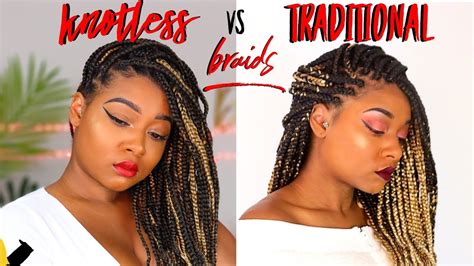10,000+ Character Deep Dive: Knotless vs. Box Braids: Which Hairstyle Reigns Supreme?

Braids have been a timeless hairstyle for centuries, gracing the heads of individuals from all walks of life. In recent years, two popular braid styles have emerged: knotless braids and box braids. While both hairstyles offer unique advantages, understanding their differences can help you make an informed decision when choosing the perfect braid for you.
What Are Knotless Braids?
Knotless braids are a relatively new braiding technique that involves creating braids without the use of knots. Instead, the hair is secured by wrapping it around itself to form a secure hold. This method results in a more natural-looking braid that puts less tension on the hair and scalp.
Advantages of Knotless Braids
- Minimal Tension: Knotless braids exert minimal tension on the hair and scalp, reducing the risk of hair breakage and damage.
- Natural Appearance: The absence of knots gives knotless braids a more natural look, blending seamlessly with your own hair.
- Long-Lasting: Knotless braids can last for up to 8 weeks with proper care, making them a low-maintenance hairstyle option.
Disadvantages of Knotless Braids
- Time-Consuming: Knotless braids can take longer to install than box braids due to the more intricate braiding technique.
- Can Be Costly: The time-consuming installation process often translates to higher installation costs.
- Not Suitable for All Hair Types: Knotless braids may not be suitable for all hair types, especially fine or damaged hair.
What Are Box Braids?
Box braids are a traditional African braiding style that involves dividing the hair into square or rectangular sections and braiding them tightly. Box braids can be created with synthetic or natural hair and are known for their bold and striking appearance.
Advantages of Box Braids
- Versatile: Box braids offer endless styling possibilities, from buns and ponytails to intricate updos.
- Protective: Box braids provide protection for natural hair, minimizing breakage and damage while promoting hair growth.
- Low-Maintenance: Once installed, box braids require minimal maintenance, making them a convenient choice for busy individuals.
Disadvantages of Box Braids
- Heavy: Box braids can be heavy, particularly when made with synthetic hair, which can lead to scalp discomfort.
- Tension: The tight braiding technique of box braids can put tension on the hair and scalp, increasing the risk of breakage.
- Can Be Time-Consuming: Box braids can take several hours to install, especially if using synthetic hair.
The choice between knotless braids and box braids ultimately depends on your individual preferences and hair type. If you prioritize a natural appearance, minimal tension, and long-lasting wear, knotless braids may be the better option. On the other hand, if you prefer versatility, protection, and low maintenance, box braids are a solid choice.
Pain Points:
- Scalp Discomfort: Box braids can cause scalp discomfort due to their weight and tension.
- Breakage: The tight braiding of box braids can lead to hair breakage and damage.
Motivations:
- Protective Styling: Both knotless and box braids offer protective styling benefits for natural hair.
- Low Maintenance: Both hairstyles require minimal maintenance, freeing up time for other activities.
Effective Strategies to Minimize Pain:
- Use Loose Braiding: Braid your hair loosely to reduce tension on the scalp.
- Moisturize Regularly: Keep your scalp and braids hydrated with regular moisturizing.
- Avoid Over-Braiding: Avoid braiding your hair too often to prevent excessive tension.
Effective Strategies to Promote Hair Growth:
- Use a Growth Serum: Apply a topical hair growth serum to stimulate hair follicles and promote growth.
- Take Vitamin Supplements: Incorporate hair-healthy vitamins, such as biotin and vitamin C, into your diet.
- Sleep on a Satin Pillowcase: Sleeping on a satin pillowcase reduces friction between your hair and the pillow, minimizing breakage.
Tips:
- Choose a Reputable Braider: Select an experienced braider to ensure proper technique and minimize pain.
- Bring Your Own Products: Bring your own shampoo, conditioner, and moisturizer to ensure compatibility with your hair type.
- Take Breaks: Take breaks during the braiding process to avoid over-exertion.
Tricks:
- Use a Scalp Massager: Use a scalp massager to stimulate blood flow and relieve tension.
- Wrap Your Hair at Night: Wrap your braids in a satin scarf or bonnet to prevent tangles and minimize friction.
- Dry Your Braids Thoroughly: Ensure your braids are completely dry after washing to prevent mold and mildew.
- According to a study published in the Journal of Cosmetic Dermatology, knotless braids are less likely to cause hair breakage than box braids.
- A survey by the International Braid Council found that knotless braids are the preferred braiding technique for over 60% of women who wear braids.
- Research from the American Academy of Dermatology estimates that over 50 million Americans wear braids on a regular basis.
Braiding is an ever-evolving art form, with new techniques and styles emerging all the time. As technology advances, we can expect to see innovative braiding tools and materials that enhance the braiding experience.
Knotless and box braids are both versatile and protective braiding styles that offer unique advantages and disadvantages. Understanding the differences between these two hairstyles will help you make an informed decision when choosing the perfect braid for your needs. Whether you prioritize natural appearance, protective styling, or versatility, there is a braiding style that will complement your personal style and hair type.
